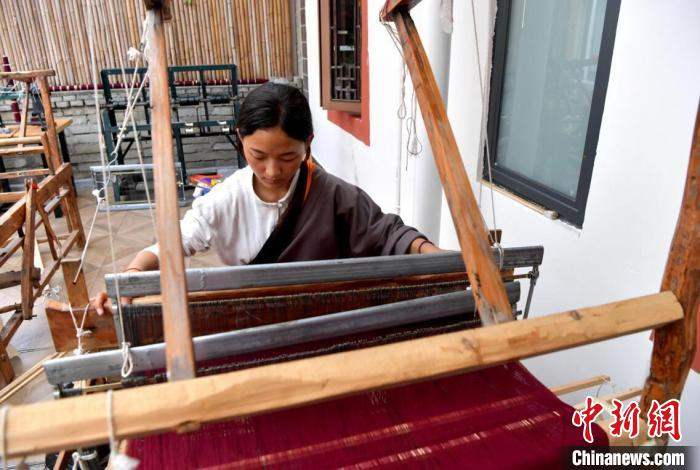Tibetan villagers weave better life with wool in SW China’s Sichuan

A villager works on a scarf in front of a loom at a workshop. (Chinanews.com/Wu Paiyong)
“This scarf is made through the use of Tibetan weaving techniques. We’ve sped up the manufacturing process in order to meet market demand,” said a Tibetan man named Shanying, who runs a workshop in Wenchuan county, southwest China’s Sichuan Province.
With each of them operating an old loom, Shanying and local villagers can skillfully turn wool into scarves with only their hands.
“My hometown is located on the plateau, where there are lots of yaks and sheep. When I was young, I saw villagers make hand-woven scarves from yak wool and sold them as high-end products, as well as making hand-woven scarves from the wool of sheep and selling them as relatively low-end products. This was a market-oriented strategy,” said Shanying, who was born in 1987 in a village in Aba Tibetan and Qiang Autonomous Prefecture, Sichuan.

Villagers make scarves at a workshop, with each of them sitting in front of a loom. (Chinanews.com/Wu Paiyong)
“It takes one week to turn raw materials into a scarf, and there are 17 steps, including dying the wool, turning it into threads, rolling the threads, threading, preparing the weft threads, and weaving the threads on the loom, among other procedures. To weave a scarf, 720 yarn pieces are needed,” Shanying introduced.
Shanying’s workshop was once located in the Aba Tibetan and Qiang Autonomous Prefecture. During a trip to the prefecture, Zou Ling, secretary of the Party committee of Yuzixi village, Wenchuan county, learned that although the hand-woven products from Shanying and his fellow villagers had distinctive ethnic characteristics, they didn’t sell well due to a lack of sales channels.
In order to help expand the sales channels for the villagers, Zou suggested that they move the workshop to Yuzixi village, which saw a strong flow of visitors. He also suggested that they showcase their weaving techniques to visitors, which would serve as a marketing strategy.
In May 2022, a workshop was built in Yuzixi village.
“In Yuzixi village, we’ve been provided places to work and live, and the catering and accommodation services are all for free. Besides, the scarves we produced here, as well as in our hometown have sold well, and the inventory has been cleared,” said Shanying. Nowadays, their handicrafts are able to reach customers in foreign countries, including Singapore, Malaysia, and Germany.

Photo shows exquisite scarves and shawls made by craftsman and craftswomen at Shanying’s workshop. (Chinanews.com/Wu Paiyong)
So far, Shanying’s workshop has produced more than 2,000 scarves, which has generated a total output value of over 2 million yuan ($298,400).
Photos
Copyright © 2022 People's Daily Online. All Rights Reserved.









